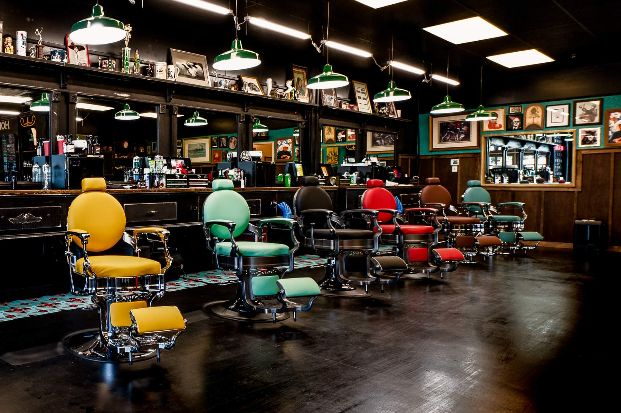Shop Tools and Equipment
The tools and equipment in each shop are vital to the shop's ability to function. Managers are expected to maintain the proper function of all tools and equipment in their shop(s).
Below are general guidelines for use of the air compressor and hoses:
Each shop should have a wi-fi enabled Honeywell thermostat. This allows for remote monitoring and control through a single login as well as a set schedule for heating and cooling. Shop temperature should not go below 68 degrees, or above 74 degrees at any time.

Air compressor and hoses
The air compressor and hoses are heavily used tools in every shop and must be monitored and maintained to ensure they are available to use. We use this air hose kit available from Harbor Freight tools and prefer the Husky silent air compressor from Home Depot.Below are general guidelines for use of the air compressor and hoses:
- The level of air pressure in the compressor tank should be set at or near 55 lbs of pressure.
- The air compressor should be drained once per week to ensure water does not build up in the bottom of the air tank. Excess water can rust the tank and cause the air to smell badly. Each compressor has a easy to access drain valve at the bottom of the air tank. Cover the nozzle with a towel and open the valve in small increments. Expect a strong release of air and some moisture.
- The air gun hose should not be tangled and overly stretched. If staff over stretch the hoses, it can cause poor connections with the piping network under the stations.
- Air hoses are connected to the station coupler with a female plug.
- Air guns are connected to the hose with a male plug.
- All air guns should have a rubber tip to prevent damage to the work station.
Towel warmers
The towel warmers have two racks that can hold about 12 towels each. Towel warmers are typically shared between two barbers. Some towel warmers last years, others will fail in 6 months. Routinely check that each towel warmer is heating properly. Often the door hinges will crack creating a poor seal around the door. Check for cracks and leaks. Towel warmer condensation trays should be emptied daily. The interiors should be wiped down monthly. Do not overfill towel warmers. Do not place dry towels inside.Shampoo bowls
The shampoo bowls are fairly easy to maintain. The drains should be caulked with clear silicone to minimize leaks. Each shampoo bowl has a hair trap device underneath that should be emptied monthly.Washer/dryer
The shop washer and dryer is likely the most heavily used tool in the shop. Check the dryer vent for excess hair and vacuum frequently. Below are some general guidelines for the washer and dryer. Depending on your service volume the frequency of your maintenance may vary. However, at the least, these should be done quarterly.- The washer drain lines should be checked for hair buildup
- The dryer vent line should be checked for lint and hair buildup
Utility sink
If your shop has a utility sink, ensure a hair trap covers the drain and inspect it routinely. Use a drain clog removal solution routinely.Bathroom sink and toilet
Routinely check the bathroom sink and toilet for any leaks. Ensure toilet isn't refilling unnecessarily.Lighting
Adequate lighting is critical for shop function. Overhead lighting should be LED daylight florescent tubes. Hanging pendant lights have a bulb splitter installed that allows for two LED daylight 100w bulbs. All overhead lights should be the same temperature (no orange lights) and all pendant lights should have two operating bulbs at all times. Ensuring proper lighting promotes great quality cuts, enhances the energy of the shop, and reduces the need for staff to bring in additional lighting, which can negatively impact the visual appeal of the brand.HVAC
The heating, ventilation, and air conditioning (HVAC) unit is a core tool for the operation of the shop. Each shop should have a bi-annual maintenance plan for their HVAC. The maintenance plan should include filter changes, cleaning, and checking for drain pan obstructions. If your HVAC filter is accessible, managers are expected to replace the filters regularly. Each shop will have a replacement frequency appropriate to their particular unit.Each shop should have a wi-fi enabled Honeywell thermostat. This allows for remote monitoring and control through a single login as well as a set schedule for heating and cooling. Shop temperature should not go below 68 degrees, or above 74 degrees at any time.
Barber chairs
The barber chairs at CHOP are a primary feature of the brand and get used very heavily. Each stylist should take great care in using and protecting the chair they are assigned. Removing excess hair and remnants from product use should be part of the daily closing routine. Each chair has a head rest that should be stowed in the ring attached to the chair when not in use. The seat, back, and arms of the chair should be cleaned daily to prevent stains. Each chair contains hydraulic fluid in the base to allow for the pedal lift. Managers are expected to monitor the lift performance and refill the hydraulic fluid if necessary. At closing, all chairs should face the same direction with headrests attached and foot pedal cushions facing out.
Refrigerator
The refrigerator is typically one of the first things customers see when they enter the shop. Because of that, and for sanitation reasons, it's important that the refrigerator be dusted regularly and the interior wiped down removing hair or any spillage from drinks inside. It's important not to overfill the refrigerator. Each can inside acts like an ice cube, lowering the overall temperature, which can result in cans freezing and exploding. For this reason, no cans should be placed inside the freezer. Damp towels may be used in the freezer for cold face applications.